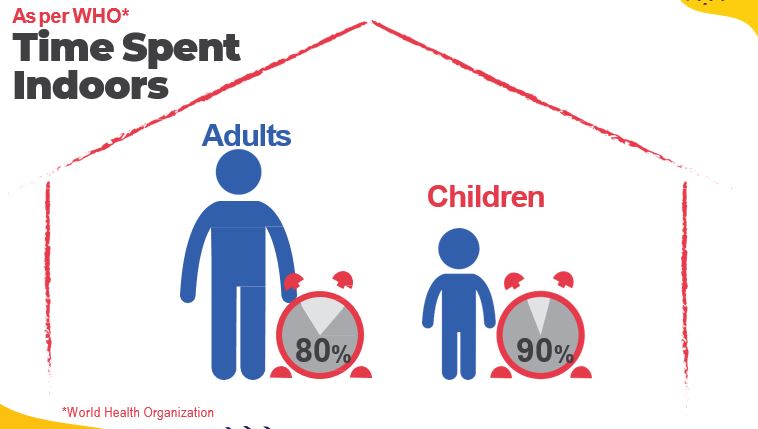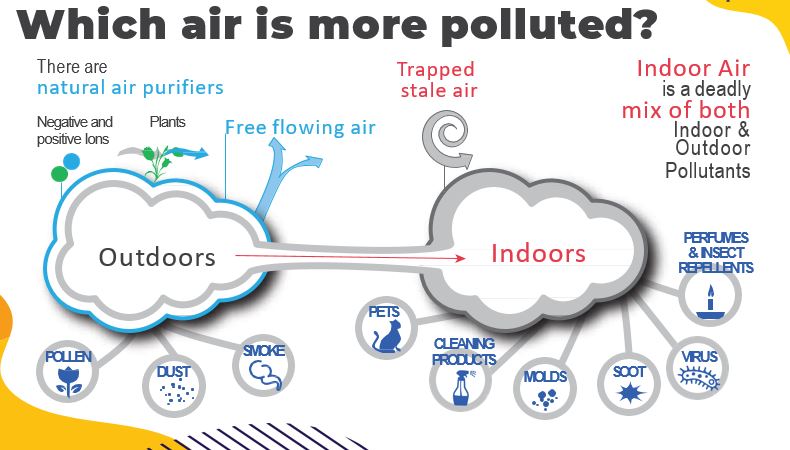Indoor Air Pollution
When you think of air pollution, you probably think of giant industrial smokestacks, or thousands of cars in gridlock traffic. Perhaps you visualize the smoggy haze that clings to big cities, or you imagine what acid rain sounds like. When you think of air pollution, you think of the air outside. Luckily you can retreat to the safety of the clean air in your home, right?
Actually, the air quality in your home can be worse than the air quality outside.

It’s easy to believe that the air quality outside is worse than the air quality inside. We know about air pollution and acid rain, we can see smoke and smell exhaust, and we might even hold our breaths when we see that semi truck spew thick clouds of black smoke ahead of us in traffic. According to the EPA, however, the levels of indoor air pollutants are often 2 to 5 times higher than outdoor levels, and in some cases these levels can exceed 100 times that of outdoor levels of the same pollutants. In other words, sometimes the air inside can be more harmful than the air outside.
Your lungs are responsible for bringing fresh air into your body, while simultaneously removing waste gases and particulates. Needless to say, the more particles that are in the air you breathe, the more difficult it is for your lungs to remove them. Poor air quality – whether it is indoors or outdoors – can make it increasingly difficult for your lungs to function properly, and can have negative health affects.
Studies have linked a number of health problems to particle pollution, including
- Premature death in people with heart or lung disease
- Nonfatal heart attacks
- Irregular heartbeat
- Asthma
- Decreased lung function
- Respiratory problems

Though it may be hard to believe, the air inside your home can be worse than the air outside. Dust and dander are notorious for lowering the air quality in your home, but there are many other pollutants that can not only dirty up the air, but lead to other health complications. Radon and carcinogens from cleaning supplies and building materials contribute to poor air quality, and can also cause cancers. VOCs (volatile organic compounds) from paint and even from some kinds of carpeting and upholstery materials can cause problems. Mold and cigarette smoke can be culprits, too.
Poor air quality can harm anyone regardless of age, but children are more susceptible to particle pollution than adults due to higher minute ventilation and higher levels of physical activity.
You should do what you can to improve the air quality in your home:
- Make sure you have adequate ventilation when using chemicals for crafts, decorating, or cleaning.
- Change air filters in your home on a monthly basis.
- Install radon detectors in every room, and regularly check them to make sure that they are working.
- Don’t smoke indoors.

Indoor Air Pollutants and Sources
A number of air pollutants have been recognized to exist indoors, including NOx, SO2, O3, CO, volatile and semi-volatile organic compounds (VOCs), PM, radon, and microorganism. Some of these pollutants (e.g., NOx, SO2, O3, PM) are common to both indoor and outdoor environments, and some of them may be originated from outdoors. These air pollutants can be inorganic, organic, biological or even radioactive. The effect of these air pollutants on humans depends on their toxicity, concentration and exposure time, and may vary from person to person. The most common effect is called sick building syndrome (SBS), in which people experience uncomfortable or acute health effects such as irritation of nose, eyes and throat, skin ailments, allergies, and so on. The cause may not be identified, but the syndrome may disappear after an affected person leaves the office or building. Indoor air quality can be improved and SBS can be reduced when the ventilation rate of the room is improved (Wargocki et al., 2000). The indoor air quality also affects the performance of workers and office staff. Wyon (2004) found that the performance of real office work would be significantly and substantially affected by changes in indoor environmental quality and that the work performance could be significantly enhanced by removing common indoor sources of air pollution.

Of course, you should also make a point to get outside! Considering that people spend as much as 90% of their time indoors, this is a real problem. Breathe in that fresh air and get some physical activity while the weather is wonderful!



